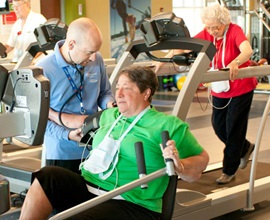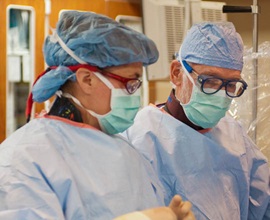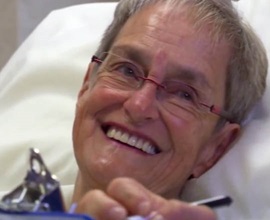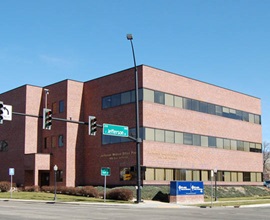
What is TAVR?
St. Luke’s is the first and only program in the area to offer TAVR, an alternative to traditional surgical aortic valve replacement if you have severe aortic valve stenosis. This procedure allows the replacement of your diseased aortic valve without open heart surgery. Using a catheter that enters your artery through a small incision in the groin, a replacement valve can be positioned while you’re under general anesthesia. Most patients are able to recover and return home on the second or third day following the procedure.
TAVR Procedure Details
A TAVR procedure is performed in an operating room while the patient is under general anesthesia for approximately 1 – 2 hours. A replacement aortic heart valve is placed in the body via a catheter that is inserted through a small puncture in the leg and threaded up to the heart through the arteries. Imaging equipment is used throughout this process to guide, position and place the new valve. The heart remains pumping throughout the procedure and once the new valve is placed it begins functioning immediately to direct blood flow out of the heart. The valve’s position and placement are then evaluated by members of the multidisciplinary team performing the procedure.
Recovery from TAVR
Following a TAVR procedure, you’ll be moved to an intensive care unit with a goal to transfer to a step-down unit the same day. Patients are encouraged to be up and walking after the procedure, typically the same day. You will likely be in the hospital for 2 – 3 days depending on your doctor’s recommendation.
Additional Considerations for TAVR
After you’re discharged from the hospital, you’re encouraged to attend cardiovascular rehabilitation for 12 weeks to support your recovery. Most patients typically follow a low-fat, low-sodium diet after the TAVR procedure. We’d like to see you one month after surgery for a follow-up appointment to monitor your progress.
Elaine's Story
TAVR gives St. Luke's patient a new lease on life.
St. Luke's is leading the way in innovative heart treatment, and making a difference in the lives of patients like Elaine.
Transcatheter Aortic Valve Replacement (TAVR) provides an alternative treatment option for people with severe symptomatic aortic valve stenosis who are not candidates for a surgical valve replacement, and who meet the TAVR criteria.
Specialties
-

Cardiac Surgery
Experienced, board-certified surgeons, highly trained nurses and technical specialists who'll ensure you receive the highest quality of care before, during, and after your surgery.
-

Cardiovascular Rehabilitation
Medically supervised program to stabilize, slow, or even reverse the progression of cardiovascular disease. -

Interventional Cardiology
Catheter-based treatment of coronary artery disease and other problems that affect the structures of your heart.



